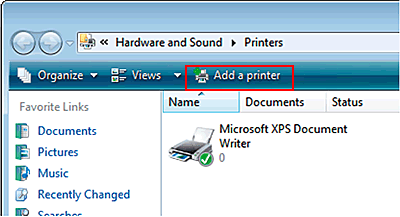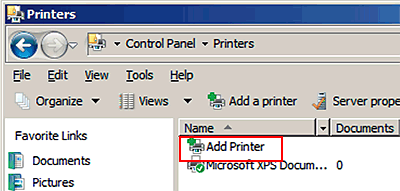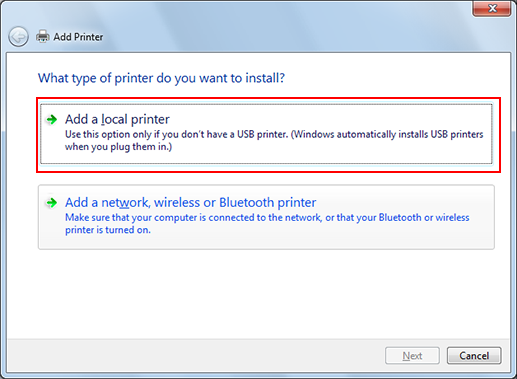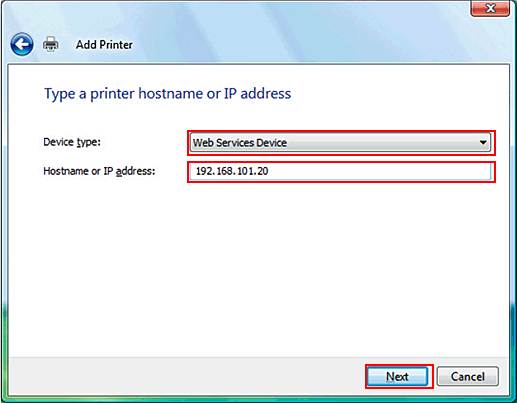For Network Connection (Web Service Print)
In Windows Vista/Server 2008/7/Server 2008 R2, printers supporting the Web service print function on the network can be located and installed.
To install a different printer driver in the computer where one has already been installed, you must uninstall the whole package of the currently installed printer driver. For details, refer to Windows.
Settings of this machine
To use the Web service print, you must configure the network settings for the machine in advance.
Items to be configured | Description |
|---|---|
IP Address | In [TCP/IP Settings] of this machine, specify the IP address. |
Web Service Setting | In [Web Service Setting] for the machine, enable the print function. |
For details on the network settings for this machine, refer to NIC Setting: Setting the Machine Network Information.
Making the printer driver known from the Network window
To use Web service print in Windows Vista/Server 2008/7/Server 2008 R2, install the printer driver before making it known to the computer with plug and play.
Installing the driver requires the administrator privilege.
Install the printer driver for this machine.
Install the printer driver using the installer or Add Printer Wizard.
The printer driver can be installed in any port.
For details, refer to Installing the PS Plug-in Driver or For Network Connection (LPR/Port 9100/SMB).
Turn on the power of this machine while it is connected to the network.
Since the printer is searched for, be sure to connect this machine to the network.To use the Web service print, check that [Network discovery] is enabled in [Network and Sharing Center] - [Change advanced sharing settings] on the computer.
Open the [Network] window.
In Windows Vista/Server 2008, click [Start], and [Network].
In Windows 7, open [Computer] and click [Network].
If [Network] is not displayed in [Computer], click the [Network and Internet] category on the [control panel], and also click [View network computers and devices].
Connected computers and devices are detected.
Right click the device name and select [Install].
To check the device name, select [Network Setting] - [Controller NIC Setting] - [Web Service Setting] - [Print Setting] in [Administrator Settings] of this machine. In the default setting, the last six characters of [printer name] correspond to the low-order three bytes of the MAC address.
To check the MAC address, select [Configuration Page]. For details about how to print [Configuration Page], refer to Report Type: Outputting a Report.
The printer driver for this machine is detected and this machine is ready to print.
After finishing the installation, make sure that the icon for the installed printer is displayed in the [Devices and Printers] or [Printers] window.
If the printer driver is not correctly installed, the driver must be updated using [Update Driver]. For details, refer to For local (USB) connection.
In Windows Vista/Server 2008, you can continue the task and specify the printer driver installation disk to install the printer driver if it is not installed in advance. When the [Found New Hardware] window is displayed, follow the displayed messages to perform the procedure. For details, refer to procedures 11 to 20 in "Installing the printer driver by specifying the IP address using the Add Printer Wizard."
In Windows 7/Server 2008 R2, you cannot specify the installation disk after the machine is connected to the computer. Install the printer driver in advance (Step 1).
Installing the printer driver by specifying the IP address using the Add Printer Wizard
In Windows Vista/Server 2008, you can add a Web service device using the addition function of the printer after connecting this machine.
In Windows 7/Server 2008 R2, you cannot install the printer driver by the following procedures.
Installing the driver requires the administrator privilege.
Turn on the power of this machine while it is connected to the network.
Since the printer is searched for during the installation, be sure to connect this machine to the network.To use the Web service print, check that [Network discovery] is enabled in [Network and Sharing Center] on the computer.
Insert the Driver CD-ROM into the CD-ROM drive.
Click [Start], and then select [Control Panel].
In Windows Vista/Server 2008, click [Printers] under [Control Panel] - [Hardware and Sound]. When [Control Panel] is displayed in Classic View, double-click [Printers].
Click [Printers] under [Hardware and Sound].
When [Control Panel] is displayed in Classic View, double-click [Printers].
Click [Add a printer] on the toolbar.
In Windows Vista:

In Windows Server 2008:

[Add Printer Wizard] appears.
Click [Add a local printer].

Click [Create a new port:], and then select the port type.
Select [Standard TCP/IP Port].
Click [Next].
Select [Web Services Device], enter the IP address, and click [Next].

A printer of the entered IP address that is compatible with the Web service print function is located, and then the [Found New Hardware] dialog box is displayed.
Click [Locate and install driver software (recommended)].
If a dialog box to confirm whether to search online is displayed, click [Don't search online].
Click [Browse my computer for driver software (advanced)].
Click [Browse].
Select a desired printer driver in the CD-ROM, and then click [Open].
Select a folder according to the printer driver, operating system, and language to be used. The available printer drivers are the PS Plug-in driver and PPD driver.
Click [Next].
Follow the instructions on the windows that follow.
If the [User Account Control] window appears, click [Continue].
If the [Windows Security] window for verifying the publisher appears, click [Install this driver software anyway].
Click [Close]
After finishing the installation, make sure that the icon for the installed printer is displayed in the [Printers] window.
Remove the CD-ROM from the CD-ROM drive.
This completes the printer driver installation.


